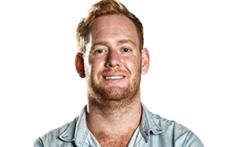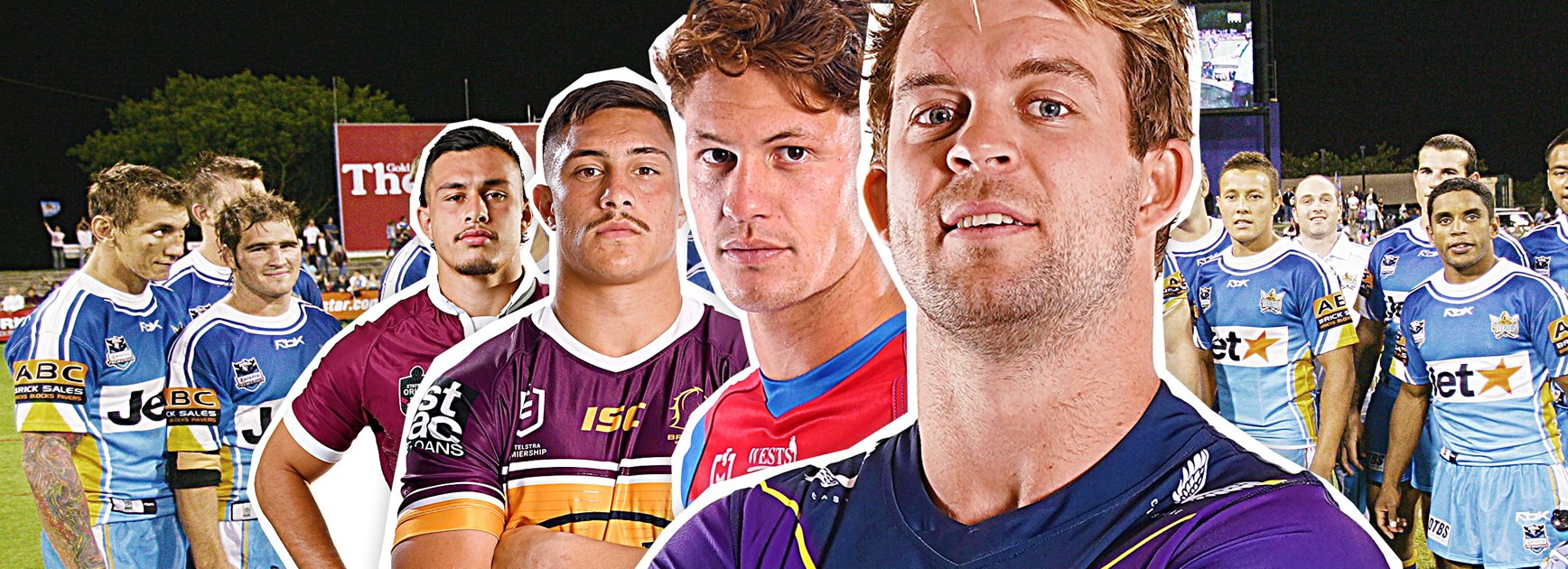
The last time a Brisbane rugby league side entered the topflight, Broncos founding father Barry Maranta offered the club's inaugural playing roster a then-unprecedented $1500 each per win.
The winning bonus was more than double any other going around in the NSWRL competition of 1988, but was offset with a $50 pay packet if the team lost.
"That will pay for petrol to get you to training and give you a strong incentive to win next week," Maranta told the players 33 years ago.
With the majority of Queensland's State of Origin side on the books and a monopoly on the Sunshine State's capital, the Broncos struck success rarely seen in the modern game, with mileage and then some too.
Now for the first time in 16 years another rare footy fantasy suddenly shapes for fruition, a fourth Queensland club potentially coming into existence, and with it a top 30 roster built entirely from scratch.
The ARL Commission will make its call on the viability of a 17th NRL side around July, with a 2023 start date slated if expansion becomes reality.
Episode 1 - Footy returns for 2021
CEO Andrew Abdo told NRL.com earlier this week that "moving to 17 teams wouldn’t be an end point. It gets you closer to 18 teams and... an 18th team allows you to think about what we might want to do about expanding in New Zealand."
Already looming for the possible 17th club though are the myriad ways to skin a salary cap for the successful bidder, as outlined by some of the game's most respected recruitment gurus, including:
- The best part of $3 million, almost a third of an NRL roster allocation, should be allocated to front-rowers and middle forwards;
- The NRL's consistent title contenders of recent years spend on average another 35% of their cap on their playmaking options;
- The need to pay "10-15 per cent" above a marquee player's market value to ensure other quality signings buy into what your selling;
- The modern-day twist on Maranta's petrol money motivator, adopted from US sports management, aimed at squeezing value from a roster's second tier.
Already, player managers and rival clubs are eyeing off the impact of a new club in the transfer market.
Short-term, one-year extensions this season are being flagged by agents to keep a client's options open in 18 months' time.
Already long-term 2022/23 off-contract lists are being scoured – with Queenslanders Cameron Munster, Harry Grant, Kalyn Ponga, Ash Taylor, Anthony Milford, Dane Gagai, Patrick Carrigan, Christian Welch, Dunamis Lui and Tino Fa'asuamaleaui among a slew of talent being pondered over.
With help from talent scouts, senior executives from across the Telstra Premiership and figures from rugby league's previous expansion frontiers, NRL.com starts from the very beginning.
How to build an NRL roster from scratch
Where clubs spend, splurge and save
All NRL outfits operate with a top 30 first-grade squad under the same revised salary cap of $9.02 million this season, $9.11m in 2022, supplemented by a minimum of three development players.
Publishing of third-party agreement in recent years, and the NRL's own crackdown on arm's length investments from the private sector, has shown a decline in the outside-the-cap payments that have long been questioned by fans.
Yet there is no doubt some clubs manage their rosters better than others.
How the best players exploit eyes-up footy
Veteran Raiders recruitment manager Peter Mulholland was the inaugural coach of Perth's Western Reds in 1995, and has developed a core of hard and fast roster rules from decades of experience.
"I believe you need four halves in your top 30, and you've got to identify those," Mulholland says.
"You've got to have at least two, perhaps three hookers, one could be a utility-style player.
"And the balance of outside backs and middles comes from that - I'd say eight middle forwards, that balance is very important."
Mulholland's analysis stacks up against roster benchmarking provided to NRL.com by staff at another of the game's premiership heavyweights of the past five seasons.
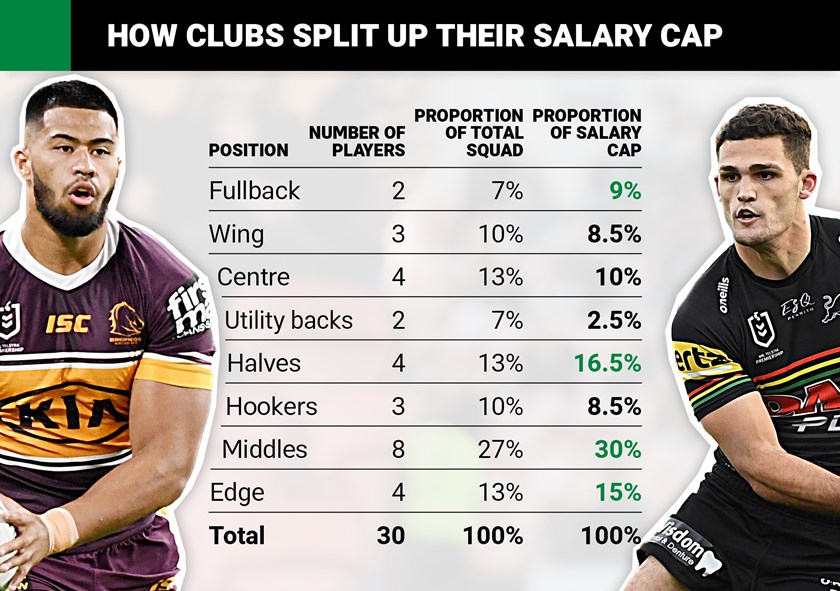
The breakdown reveals the game's top clubs place a premium on middle forwards, allocating 30% of spending to their go-forward.
"You've got to get two quality props at least, because people play off the back of that," Mulholland says when asked for his first move in starting a new club.
"They're incredibly important, you've got to have your go-forward sorted early on because your quality playmakers, that's always a strong consideration for them.
"They can't do a hell of a lot if their front-rowers are getting beaten consistently."
Fullbacks and halves deservedly take a higher proportion of cap space to roster numbers given their importance in the modern game.
The devil in spending an average of almost $1.5 million on four halves is the detailed spread of those wages.
The key player signings to watch in 2021
NRL.com estimates 12 of the 16 current clubs have a playmaker earning around $900,000 a season or more, entirely reasonable considering the influence they hold over a team's fortunes.
With figures like Brisbane Jets spokesman Nick Livermore not so-subtly mentioning players like Grant or Munster as the type a club can be build around, a similar marquee outlay looms for a prospective 17th side.
A club such as South Sydney though represents the outlier.
The presence of Damien Cook, Cameron Murray and Latrell Mitchell as top-tier earners in other positions in turn has seen slightly less spent on their first-choice halves Adam Reynolds and Cody Walker in recent years.
Reynolds is believed however to have bumped up to around the $800-900,000 mark in 2021, the final season of his current contract.
Latrell with the freakish offload for Walker
Yet while most of the NRL's million-dollar men ply their trade out of the scrumbase, their reinforcements in a top 30 squad typically sit in slots 20-30 of a roster.
Having built champion lists at the Storm and the Roosters, Warriors recruitment manager Peter O'Sullivan is weighing up a more even spread of the club's top tier once Roger Tuivasa-Sheck's estimated $1 million contract finishes with his move to rugby in 2022.
Asked how he would approach the top end of his cap if building from the ground floor, O'Sullivan says: "No doubt you need a senior player, an out-and-out leader in your top few earners.
"So that type, maybe your captain, could be your outlier in terms of what you pay them.
"I'd say looking at maybe $800-900 for your top-tier two or three players, maybe working down to $700 or a bit less for your next three players.
"That's a reasonably safe blend leaving you with enough to balance the rest of the roster with tradesman-like players and young up-and-comers to provide real value."
Three for one special: the value in versatility
The big earners are where any club, especially a start-up Brisbane outfit, must start.
"We wanted a marquee halfback and a marquee front-row because plain and simple, that's who people want to play with," inaugural Titans coach John Cartwright says.
"We got Scott Prince, Preston Campbell and Luke Bailey early on, and Princey at that stage was a Queensland and Australian rep, a grand final-winning captain and halfback in the past two years, he was in career best form.
"He was just about as big as we could go."
Mulholland took a similar approach in the mid-90s luring Mark Geyer and Brad Mackay across to WA.
"You acknowledge you might have those blokes earning 10-15% more than your next tier," he says.
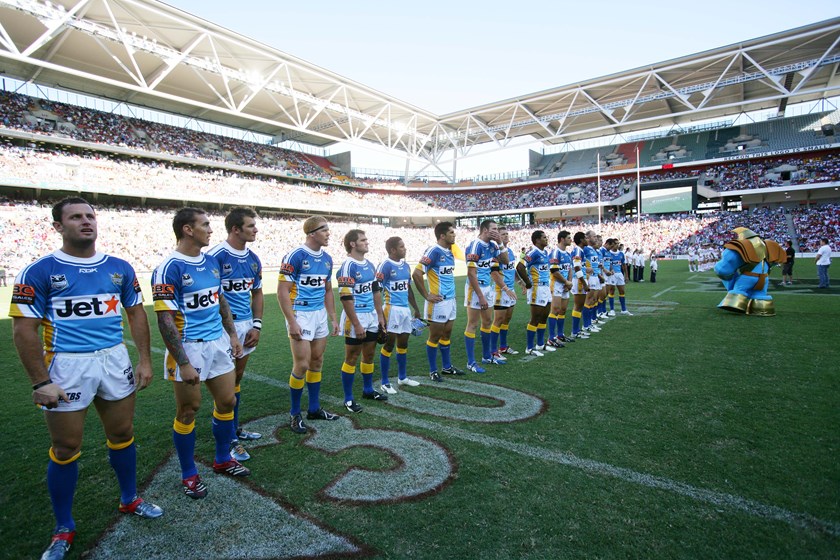
"And potentially that same figure above what the market might dictate, but it's worth it because it will open the door for others."
But while centres and wingers rarely see the big bucks, they are a potential gold mine in the overall roster scheme.
If a player has the ability to back up multiple positions, a club gets further value from the one roster spot while minimising against the drain of injury and representative periods.
"In your outside backs, that is one area you can get a lot of value if you look to versatility, that is blokes that can play two or three positions comfortably," Mulholland says.
Raiders employ the power game
"[Veteran Eels flyer] Michael Oldfield for example, he's a brilliant player for a new franchise.
"Bailey Simonsson as well, they offer cover right across your wing, centre and fullback."
Playmaking utilities and mobile forwards offer similar advantages, with the lower to mid-tier of a roster where a recruitment manager often does their best work.
From petrol money to The Pyramid Scheme
Which brings us back to Maranta's $1500 for a win, $50 for fuel incentives.
Mulholland has adopted his own version from the US that has served him since those western frontier days with the Reds.
Splitting a roster into three tiers once more, not by salary, but by what drives any given individual.
Fox League 2021 season showcase
"Your top echelon of players, rep players and elite guys, they're intrinsically motivated to be the best they can be," he says.
"They know they'll get decent money because they've performed before and earned that before - their performance and maybe pride is what drives them.
"At the bottom of the pyramid are your young players. The ones that are aspiring to get to the top, who can get those rewards eventually, but first they're driven by the opportunity.
"Then in the middle are your journeyman or mid-tier players that are extrinsically motivated, if you like. Money is a motivator to a degree, like it is for anyone in any profession.
"And I like to put bonuses in their contracts for those players.
"These are the guys that aren't going to be internationals or Origin players, but every club needs them.
"You need them performing to the best of their ability in first grade, because they can be genuine first-graders and realistically you need 10-12 of these guys.
"If a bonus gets that next level out of them, why not?"
Your top echelon of players, they're intrinsically motivated to be the best they can be.
Peter Mulholland
It's a system that requires intimate understanding of a club's salary cap and the constantly shifting sands.
Most outfits now sail at least $100,000 shy of the salary cap's ceiling for multiple reasons, be it keeping cash free for an eleventh hour signing or accounting for representative and individual bonuses.
And most clubs have a specific "number cruncher" on the books to keep them balanced.
At Canberra, Rikki Cronin and Warwick Burr go over Mulholland's work with a fine-tooth comb, now-Sharks CFO Vince Costa held a similar role at Canterbury, and Broncos company secretary Louise Lanigan keeps things in check at Red Hill.
Yet while there's plenty of ways to carve up a salary cap, there's the danger of cooking it too.
Rookie reflections: Stephen Crichton
Don't believe the hype: danger in the early days
After heading up the Titans return to the NRL in 2007, Cartwright eventually walked from his Titans post seven years later to ensure he wasn't frog-marched from the building.
Four consecutive bottom eight finishes left his position untenable.
Had it not been for two late-season fade-outs, the Gold Coast's first two campaigns could well have matched the top four finishes of 2009 and 2010.
He and CEO Michael Searle had certainly set up the side to be competitive from day dot with Scott Prince, Luke Bailey, Preston Campbell, Anthony Laffranchi, Mat Rogers, Brad Meyers, Michael Hodgson and Chris Walker forming the nucleus of his 2007 squad.
"You can look at targeting a young team that will develop in the future, knowing you're probably in for a bit of pain early on, a bit GWS [Giants] in the AFL," Cartwright says.
"But given the Gold Coast's history with previous franchises, we wanted to be strong from the word go.
"We had to invest in experience to do that - mature guys with 150 first-grade games."
With Queensland Origin lock Ashley Harrison signing a year later, the Gold Coast had a genuinely strong top tier on their roster, only to have their depth found wanting when injuries took their toll over a season.
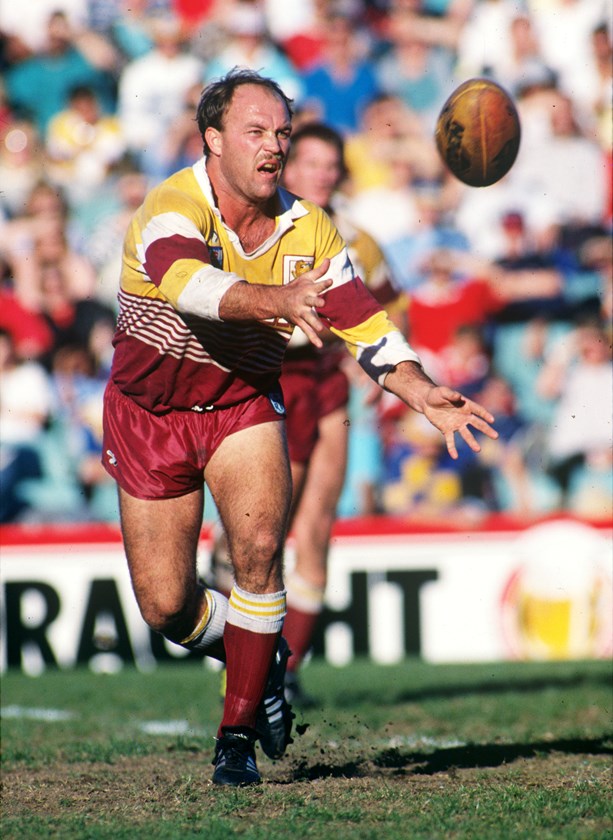
Cartwright concedes the downside of targeting an established side from the outset eventually proved his downfall.
"The biggest mistake that I made was probably around the succession planning," he says.
"Signing guys at the peak of their career to start meant they all finished or came off contract around the same time.
"The key to recruiting an experienced team like we did was to have a succession plan around them and be ready to turn over, or have your development really kick on within three or four years.
Match Highlights: Titans v Warriors
"When our big names retired we relied too much on the young kids coming through and they couldn't match the standards of our marquee players."
Ending up a bargaining chip every time contract discussions take place anywhere in the game is another pitfall looming should a new Brisbane franchise get the green light.
The Titans regularly had "plans A, B, C and D" at the ready for the negotiations that didn't come off.
The biggest mistake that I made was probably around the succession planning.
John Cartwright
For any incoming 17th club, the hallmark of 2020's grand final outfits should loom as large as any.
Of the 17 players Melbourne and Penrith each fielded last October, both sides had 13 one-club players in their midst, the majority of them developed in their respective systems since their teens.
An NRL-ready side won't be dug up from south-east Queensland soil in 2023.
Match Highlights: Panthers v Storm
But given the region's strong rugby league roots and the QRL's plans for extensive pathways development, the secret to long-term roster success is just as much in their own backyard as the market.
"You've got to properly invest in junior development. That's got to be a non-negotiable and core of your club," O'Sullivan concludes.
"I'd have a bucket load of 15-, 16-, and 17-year-old kids in a high-performance centre with someone who knows development. You need that flow-on of talent coming through.
"The best way to win NRL competitions, in my opinion, is to win SG Ball competitions or the equivalent in Queensland and have those successful teams coming through together.
"There's more than enough proof around the game that it works."
